Are you an LGBTQ+ traveler seeking an unforgettable experience in Mexico? Seeing the monarch butterfly migration is a breathtaking natural phenomenon, and with gaymexico.net, you can discover the best and safest places to witness this spectacle. This guide provides all the information you need, combining stunning natural beauty with LGBTQ+-friendly travel tips, including top sanctuaries, optimal viewing times, and essential safety advice. Plus, find the best resources on inclusive accommodations and travel planning, ensuring your Mexican adventure is both magical and secure.
1. What Makes The Monarch Butterfly Migration in Mexico So Special?
The monarch butterfly migration to Mexico is special because it’s a unique natural phenomenon where millions of butterflies travel thousands of miles to overwinter in specific regions of Mexico. These delicate creatures, each weighing about as much as a paperclip, undertake an incredible journey of up to 2,800 miles from Canada and the United States to the oyamel fir forests of central Mexico. According to research from the University of California, Davis, monarch butterfly populations have declined significantly in recent decades, making the conservation efforts in Mexico vital to their survival. This migration is not only the longest of any insect, but it also involves a special “Methuselah generation” of butterflies that live up to nine months, enabling them to make the journey that shorter-lived monarchs cannot. The cultural significance of the monarchs in Mexico, where they are believed to be the souls of ancestors returning during Dia de los Muertos (Day of the Dead), adds to the magic of witnessing this natural wonder.
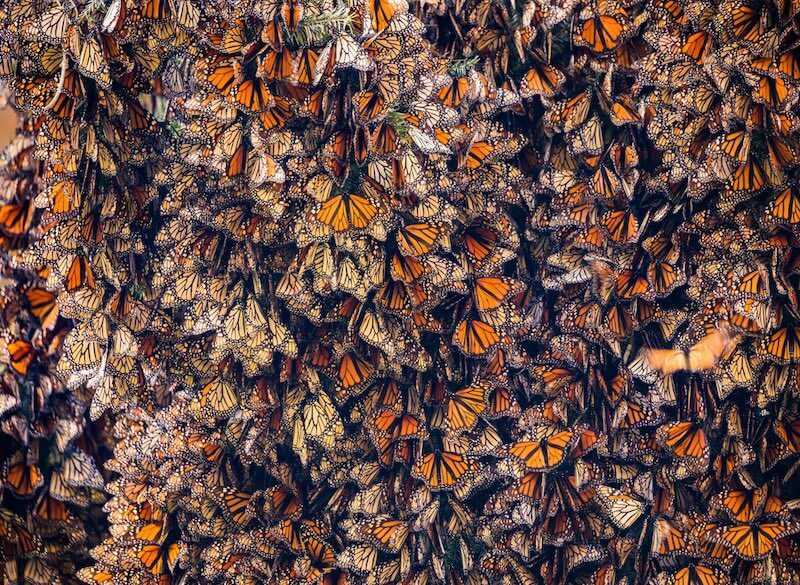 Millions of monarch butterflies
Millions of monarch butterflies
1.1 What Is The “Methuselah Generation” of Monarch Butterflies?
The “Methuselah generation” refers to the unique group of monarch butterflies born at the end of summer that live up to nine months, unlike the typical 3-4 week lifespan of other adult monarchs. These butterflies are crucial for the monarch migration, as they are the only ones that live long enough to complete the journey from Canada and the United States to central Mexico. During their time in the north, they store energy from nectar and milkweed, fueling their long flight to overwintering sites. As documented by the World Wildlife Fund, the Methuselah generation relies on specific environmental cues to initiate their migration, making them particularly vulnerable to climate change and habitat loss.
1.2 What Is The Cultural Significance Of Monarch Butterflies In Mexico?
In Mexican culture, monarch butterflies are deeply intertwined with the celebration of Dia de los Muertos (Day of the Dead). Local indigenous communities believe that the butterflies are the souls of their departed loved ones returning to visit the living. This belief adds a spiritual dimension to the monarch butterfly migration, turning it into a sacred event where nature and ancestral spirits converge. The butterflies are honored and protected, reflecting the profound respect Mexicans have for these creatures. According to research from the National Autonomous University of Mexico (UNAM), this cultural reverence has historically contributed to the conservation of the monarch butterfly biosphere reserves.
2. Is It Safe For LGBTQ+ Travelers To Visit The Monarch Butterfly Sanctuaries?
Visiting the monarch butterfly sanctuaries in Mexico is generally safe for LGBTQ+ travelers, but it’s essential to be aware of local customs and attitudes. While the areas around the sanctuaries are relatively rural and traditional, they are also accustomed to tourists from around the world. Common-sense safety precautions, like those you would take in any travel destination, should be observed. According to a report by Human Rights Watch, attitudes toward LGBTQ+ individuals in Mexico are becoming more accepting, particularly in tourist areas, but it’s always wise to stay informed and vigilant. Resources like gaymexico.net can provide updates and specific advice for LGBTQ+ travelers in Mexico, ensuring a safe and enjoyable experience.
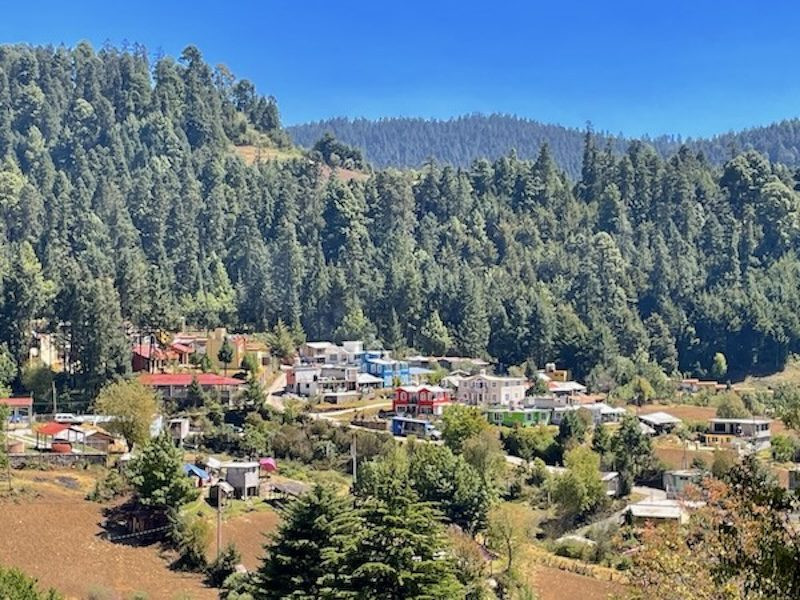 Landscape near the butterfly sanctuary in Mexico
Landscape near the butterfly sanctuary in Mexico
2.1 What Safety Precautions Should LGBTQ+ Travelers Take?
LGBTQ+ travelers should take standard safety precautions, such as being aware of their surroundings, avoiding displays of affection in more conservative areas, and researching local laws and customs. It’s also advisable to have emergency contacts and information readily available.
- Research local attitudes: Understand the local perspectives on LGBTQ+ rights and customs.
- Avoid public displays of affection: Exercise discretion in public spaces, particularly in rural areas.
- Stay informed: Keep up-to-date with any travel advisories or safety alerts.
- Use trusted transportation: Opt for reputable taxi services or ride-sharing apps.
- Share your itinerary: Let someone know your travel plans and check in regularly.
2.2 Are There Specific LGBTQ+-Friendly Tour Options Available?
While specific LGBTQ+-friendly tours to the monarch butterfly sanctuaries may be limited, many tour operators are inclusive and welcoming. It’s best to inquire directly with tour companies about their policies and inclusivity practices. Websites like gaymexico.net can also provide recommendations for LGBTQ+-friendly travel services in Mexico, including transportation and accommodations.
3. When Is The Best Time To See The Monarch Butterflies In Mexico?
The best time to see monarch butterflies in Mexico is generally from January to mid-March, with the peak usually in late January and February. During this period, the butterflies are densely clustered in the oyamel fir forests, creating a spectacular sight. The monarchs arrive in early November and begin their return journey northward in March. Visiting in January or February ensures you’ll witness the largest concentrations of butterflies. According to the Monarch Butterfly Biosphere Reserve, the butterflies are most active around midday when the sun is out and temperatures are warmer, allowing for optimal viewing conditions.
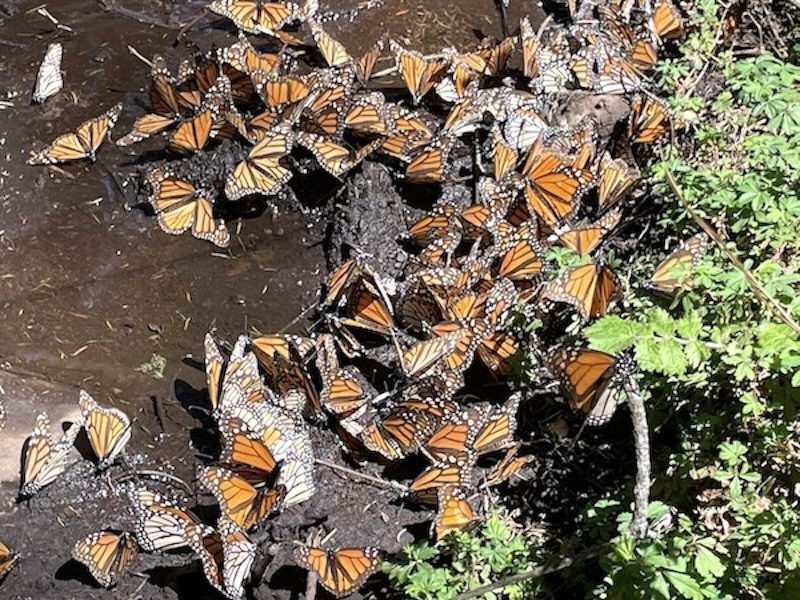 Monarchs in Mexico
Monarchs in Mexico
3.1 How Does The Weather Affect Monarch Butterfly Activity?
Weather plays a significant role in monarch butterfly activity. On sunny days, the butterflies are more active, opening their wings to absorb warmth and flying around in large numbers. On cloudy or cold days, they tend to cluster together more tightly in the trees to conserve heat, making them less visible in flight. The ideal viewing conditions involve clear skies and moderate temperatures, usually between 60°F and 70°F (15°C to 21°C). According to the Commission for Environmental Cooperation, extreme weather events, such as severe cold snaps or heavy rainfall, can negatively impact the butterfly colonies.
3.2 Should I Visit On A Weekday Or Weekend?
Visiting the monarch butterfly sanctuaries on a weekday is highly recommended to avoid the larger crowds that typically visit on weekends. Weekday visits offer a more peaceful and intimate experience, allowing you to better appreciate the natural wonder without the distraction of large groups. Weekends can be particularly crowded with both local and international tourists, which may also impact the availability of guides and other services. Local sources often advise that visiting during the week provides a more relaxed and immersive experience.
4. Where Are The Best Places To See Monarch Butterflies In Mexico?
The best places to see monarch butterflies in Mexico are within the Monarch Butterfly Biosphere Reserve, a UNESCO World Heritage site located between Mexico City and Morelia. The most popular sanctuaries in Michoacan are El Rosario and Sierra Chincua, known for their large butterfly populations and well-maintained trails. In Mexico State, Piedra Herrada is the most frequently visited sanctuary due to its proximity to Mexico City. Each sanctuary offers a unique experience, with varying levels of difficulty for hiking and different amenities. According to UNESCO, these reserves are crucial for the conservation of the monarch butterfly migration and provide essential habitat for the overwintering colonies.
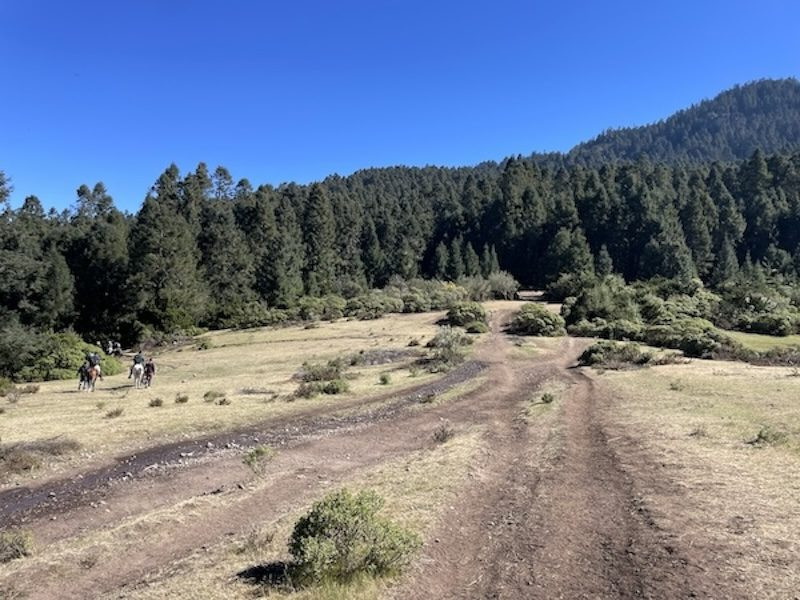 Horses walking to the monarch butterflies in Mexico
Horses walking to the monarch butterflies in Mexico
4.1 El Rosario Sanctuary
- Location: Michoacan
- Accessibility: Well-maintained trails, horseback riding available
- Highlights: Largest colony, excellent tourist infrastructure
- Considerations: Can be crowded, especially on weekends
4.2 Sierra Chincua Sanctuary
- Location: Michoacan
- Accessibility: Moderate hike, some steep sections
- Highlights: Beautiful forest setting, fewer crowds than El Rosario
- Considerations: Higher altitude may affect some visitors
4.3 Piedra Herrada Sanctuary
- Location: Mexico State (near Mexico City)
- Accessibility: Easier hike, suitable for families
- Highlights: Closest sanctuary to Mexico City, good for a day trip
- Considerations: May be less impressive than the Michoacan sanctuaries
4.4 How Do I Get From Mexico City To The Monarch Butterfly Biosphere Reserve?
Getting from Mexico City to the Monarch Butterfly Biosphere Reserve involves a combination of driving and local transportation. You can rent a car at the Mexico City airport and drive to the sanctuaries, which takes approximately 3-4 hours. Alternatively, you can take a bus from Mexico City to towns near the sanctuaries, such as Angangueo or Zitácuaro, and then hire local transportation like taxis or combis (shared vans) to reach the reserve. Organized tours from Mexico City are also available, providing a hassle-free option with transportation and guided visits included. According to the Mexico Tourism Board, driving allows for flexibility, while buses and tours offer convenience.
5. What Is It Like Inside The El Rosario Monarch Butterfly Sanctuary?
Inside the El Rosario Monarch Butterfly Sanctuary, visitors are immersed in a world of natural wonder. After paying the entrance fee, you have the option to hike or rent a horse for part of the ascent. The trail winds through a beautiful forest, and as you get closer to the colony, you’ll start to see more and more butterflies. Upon reaching the main area, millions of monarchs cover the trees, creating a breathtaking spectacle. The sound of their wings is like a gentle rustling, and the sight of them taking flight is unforgettable. According to visitor reviews, it’s an emotional and awe-inspiring experience that highlights the beauty of nature.
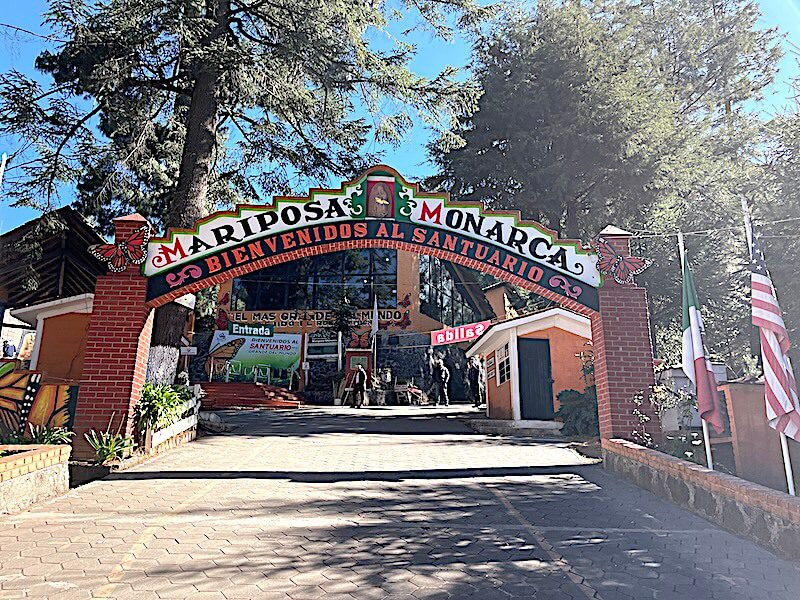 Butterfly migration gate in Mexico
Butterfly migration gate in Mexico
5.1 Should I Hire A Guide?
Hiring a guide is highly recommended for visiting the monarch butterfly sanctuaries. Guides provide valuable information about the butterflies, the ecosystem, and the local culture. They can also help you navigate the trails and ensure you have the best viewing experience. While some sanctuaries may not always have English-speaking guides readily available, it’s worth asking around or booking in advance to secure one. Local guides are often knowledgeable about the best spots for viewing and can enhance your understanding and appreciation of the monarch migration.
5.2 To Hike Or To Horse?
Choosing between hiking and horseback riding depends on your physical condition and personal preference. Hiking allows for a more immersive experience, letting you take your time and fully appreciate the surroundings. However, the altitude and steep terrain can be challenging for some. Horseback riding can make the ascent easier, especially for those with mobility issues, but it only takes you part of the way, with a final section that must be hiked. Consider your fitness level and the type of experience you’re seeking when making your decision.
6. Essential Tips For Seeing The Butterflies In Mexico
To make the most of your visit to the monarch butterfly sanctuaries in Mexico, keep these essential tips in mind:
- Visit on a weekday: Avoid the weekend crowds for a more peaceful experience.
- Dress in layers: The weather can change quickly at high altitudes.
- Plan for two full days: Allow flexibility in case of bad weather.
- Rent a car cautiously: Document any existing damage to avoid disputes.
- Book accommodations early: Options are limited and fill up quickly.
- Bring small change: Needed for restrooms and small purchases.
- Arrive early: Get to the reserve around 10:30 AM to reach the top by noon.
- Acclimatize to the altitude: Take it easy on your first day to avoid altitude sickness.
 Monarchs in the trees in Mexico
Monarchs in the trees in Mexico
6.1 What Should I Pack For The Trip?
- Comfortable walking shoes or hiking boots: Essential for navigating the trails.
- Layers of clothing: Including a light jacket or sweater, as temperatures can vary.
- Sunglasses or a sun hat: To protect against the sun at high altitudes.
- Water: Stay hydrated during the hike.
- Backpack: To carry essentials like water, snacks, and a camera.
- Camera with a good zoom: To capture the butterflies without disturbing them.
- Cash: Many local vendors do not accept credit cards.
- Snacks: To keep your energy up during the hike.
- Chapstick: The air can be very dry at high altitudes.
6.2 What Are The Rules For Visiting The Sanctuaries?
To protect the monarch butterflies and their habitat, visitors are expected to follow certain rules:
- Stay on marked trails: Avoid straying off the designated paths.
- Maintain silence: Keep noise levels down to avoid disturbing the butterflies.
- No flash photography: The flash can disorient the butterflies.
- No touching the butterflies: Respect their delicate nature.
- No food or drinks near the colony: To prevent litter and disturbance.
- Limit your time at the top: To allow others to enjoy the experience.
- Follow guide instructions: Listen to your guide for additional guidelines.
7. How Much Does It Cost To See The Monarch Butterflies In Mexico?
The cost of visiting the monarch butterfly sanctuaries in Mexico can vary depending on your travel style and choices. Here’s a breakdown of typical expenses:
- Parking: 50 pesos
- Horses: 170 pesos per person (each way)
- Entrance: 80 pesos per person
- Organized tours: 1500 to 5000 pesos (depending on the sanctuary and duration)
In total, a couple can expect to spend around 890 pesos ($52.30 USD) for a basic visit, excluding transportation and accommodation. Organized tours offer a more inclusive package but come at a higher price. According to budget travel guides, planning and booking in advance can help reduce costs.
7.1 Are There Ways To Save Money On The Trip?
- Travel during the off-peak season: Prices for accommodations and tours may be lower.
- Use public transportation: Buses are a cheaper alternative to renting a car.
- Pack your own food and drinks: Avoid buying overpriced items at the sanctuaries.
- Stay in budget-friendly accommodations: Hostels or guesthouses can save money.
- Look for free activities: Explore the local towns and markets.
7.2 Should I Book An Organized Tour Or Travel Independently?
The decision to book an organized tour or travel independently depends on your preferences and budget. Organized tours offer convenience, transportation, and guided visits, making them ideal for those who prefer a hassle-free experience. Independent travel allows for more flexibility and can be more cost-effective, but it requires more planning and effort. Consider your comfort level with navigating new places and your desire for structure versus freedom when making your choice.
8. Where To Stay To See The Mexico Butterflies
The choice of where to stay depends on which sanctuary you plan to visit:
- Piedra Herrada: Stay in Valle de Bravo, a charming town known as the “Hampton’s of Mexico City.”
- El Rosario: Stay in Angangueo, a small, historic mining town close to the sanctuary.
- Sierra Chincua: Stay in either Ocampo or Angangueo, both within reasonable driving distance.
Angangueo offers a more immersive local experience, while Valle de Bravo provides more upscale amenities. Booking accommodations early is crucial, as options are limited and fill up quickly during the peak season.
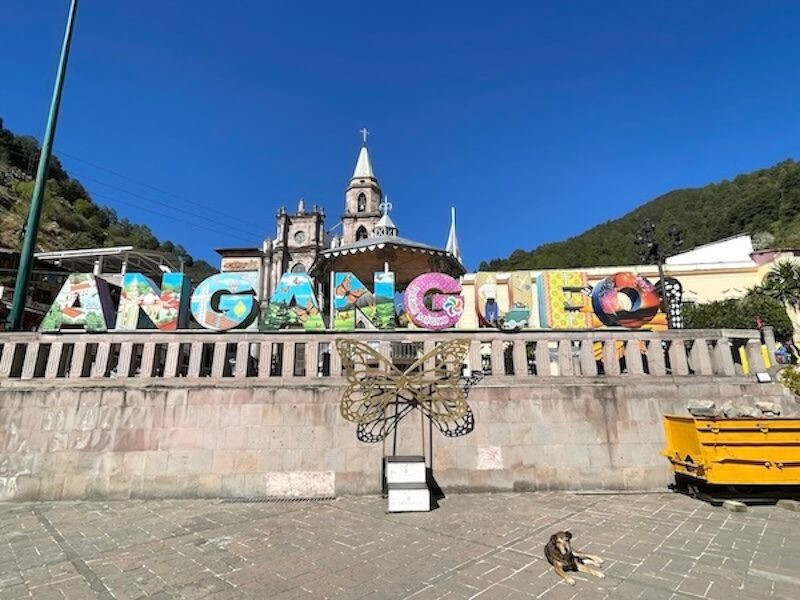 Angangueo sign with blue sky
Angangueo sign with blue sky
8.1 Are There LGBTQ+-Friendly Accommodations In These Areas?
While there may not be explicitly LGBTQ+-labeled accommodations in these smaller towns, many hotels and guesthouses are welcoming to all guests. It’s always a good idea to read reviews and inquire directly with the accommodations about their inclusivity policies. Websites like gaymexico.net may offer recommendations for LGBTQ+-friendly accommodations in nearby cities like Mexico City or Morelia, which can be combined with day trips to the sanctuaries.
8.2 What Are The Accommodation Options Like In Angangueo?
Accommodation options in Angangueo are generally basic but clean. You can find small hotels, guesthouses, and family-run lodgings that offer a comfortable stay. Many accommodations are within walking distance of the town center and offer easy access to local restaurants and shops. While amenities may be limited compared to larger cities, the charm and hospitality of Angangueo make it a unique and rewarding place to stay.
9. Combine Your Visit With Other Nearby Attractions
To make the most of your trip, consider combining your visit to the monarch butterfly sanctuaries with other nearby attractions:
- Mexico City: Explore the vibrant capital with its rich history, culture, and culinary scene.
- Morelia: Visit the beautiful colonial city, a UNESCO World Heritage site.
- Valle de Bravo: Enjoy water sports, hiking, and stunning views in this picturesque town.
- Pueblos Mágicos: Discover other charming “magic towns” in the region, such as Tlalpujahua or El Oro.
Combining your butterfly adventure with other destinations allows you to experience the diversity and beauty of central Mexico.
9.1 Can I Combine Whale Watching With A Butterfly Trip?
Yes, you can combine whale watching in Puerto Vallarta with a visit to the monarch butterflies if you travel in January or February. Fly into Mexico City, see the butterflies, then take a one-hour flight to Puerto Vallarta to witness the humpback whales. This combination offers a unique wildlife-filled trip, showcasing the natural wonders of Mexico.
9.2 What Are Some LGBTQ+-Friendly Activities In Mexico City?
Mexico City is known for its vibrant LGBTQ+ scene. Some popular activities include:
- Zona Rosa: Explore the LGBTQ+ neighborhood with its bars, clubs, and shops.
- Museo Soumaya: Visit this stunning museum with a diverse collection of art.
- Xochimilco: Take a траjinera (boat) ride through the canals.
- Lucha Libre: Attend a wrestling match for a fun and unique cultural experience.
- Gay Pride Parade: If visiting in June, don’t miss the annual pride parade.
Resources like gaymexico.net provide comprehensive guides to LGBTQ+ events and venues in Mexico City.
10. FAQ: Your Questions Answered
10.1 When Is The Best Time To See The Mexican Butterfly Migration?
January and February are the best months to guarantee seeing millions of butterflies.
10.2 How Much Time Do You Need At The Sanctuaries?
Plan for at least four hours to take your time and fully experience the sanctuary.
10.3 Which Is The Best Place To See Monarch Butterflies In Mexico?
El Rosario is the most popular and has the best tourist infrastructure, with Sierra Chincua a close second.
10.4 Are Credit Cards Accepted At The Sanctuaries?
Credit cards are generally not accepted. Bring enough cash for parking, entrance fees, souvenirs, and tips.
10.5 Is It Possible To See The Butterflies Without Hiking?
Horseback riding is available at some sanctuaries, reducing the amount of hiking required, but a final section must be hiked on foot.
10.6 Are There Restrooms At The Sanctuaries?
Yes, there are restrooms available, but they typically charge a small fee (around 6 pesos) and provide a limited amount of toilet paper.
10.7 Can I Bring Food And Drinks Into The Sanctuaries?
It’s best not to bring food and drinks near the butterfly colony to avoid litter and disturbance.
10.8 Are There Any Language Barriers For English Speakers?
While some guides and locals may speak English, it’s helpful to learn basic Spanish phrases to enhance your experience.
10.9 What Is The Altitude Like At The Sanctuaries?
The sanctuaries are located at high altitudes (around 9,000 feet), so take it easy on your first day to avoid altitude sickness.
10.10 How Can I Contribute To Monarch Butterfly Conservation?
Support organizations working to protect monarch butterflies and their habitat, plant milkweed in your garden, and educate others about the importance of conservation.
Ready to witness the magic of the monarch butterflies in Mexico? Visit gaymexico.net for more information on LGBTQ+-friendly travel, accommodations, and insider tips to make your trip unforgettable. Explore our detailed travel guides, discover hidden gems, and connect with a welcoming community. Start planning your adventure today and experience the beauty and diversity of Mexico safely and authentically.